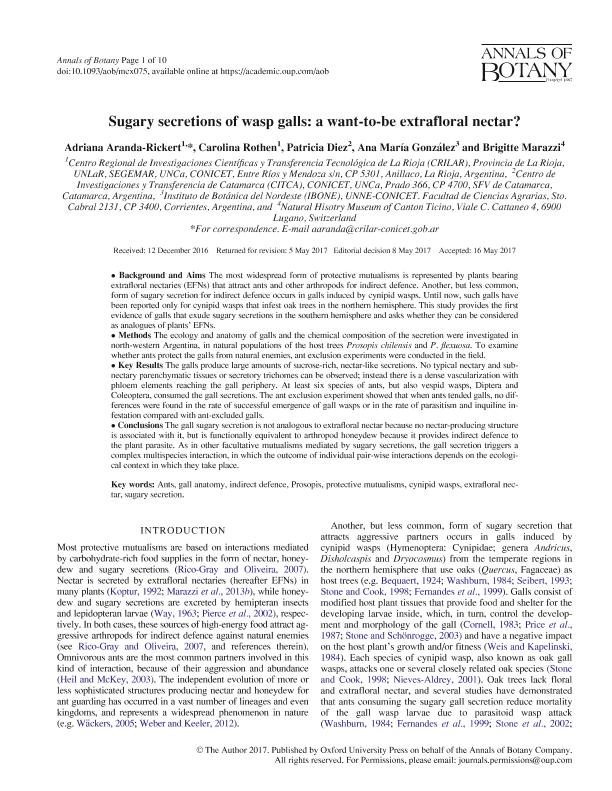Artículo
Sugary secretions of wasp galls: a want-to-be extrafloral nectar?
Aranda Rickert, Adriana Marina ; Rothen, Carolina Paola
; Rothen, Carolina Paola ; Diez, Patricia Alejandra
; Diez, Patricia Alejandra ; González, Ana María
; González, Ana María ; Marazzi, Brigitte
; Marazzi, Brigitte
 ; Rothen, Carolina Paola
; Rothen, Carolina Paola ; Diez, Patricia Alejandra
; Diez, Patricia Alejandra ; González, Ana María
; González, Ana María ; Marazzi, Brigitte
; Marazzi, Brigitte
Fecha de publicación:
06/2017
Editorial:
Oxford University Press
Revista:
Annals of Botany
ISSN:
0305-7364
e-ISSN:
1095-8290
Idioma:
Inglés
Tipo de recurso:
Artículo publicado
Clasificación temática:
Resumen
Background and Aims: The most widespread form of protective mutualisms is represented by plants bearing extrafloral nectaries (EFNs) that attract ants and other arthropods for indirect defence. Another, but less common, form of sugary secretion for indirect defence occurs in galls induced by cynipid wasps. Until now, such galls have been reported only for cynipid wasps that infest oak trees in the northern hemisphere. This study provides the first evidence of galls that exude sugary secretions in the southern hemisphere and asks whether they can be considered as analogues of plants’ EFNs. Methods: The ecology and anatomy of galls and the chemical composition of the secretion were investigated in north-western Argentina, in natural populations of the host trees Prosopis chilensis and P. flexuosa. To examine whether ants protect the galls from natural enemies, ant exclusion experiments were conducted in the field. Key Results: The galls produce large amounts of sucrose-rich, nectar-like secretions. No typical nectary and sub-nectary parenchymatic tissues or secretory trichomes can be observed; instead there is a dense vascularization with phloem elements reaching the gall periphery. At least six species of ants, but also vespid wasps, Diptera and Coleoptera, consumed the gall secretions. The ant exclusion experiment showed that when ants tended galls, no differences were found in the rate of successful emergence of gall wasps or in the rate of parasitism and inquiline infestation compared with ant-excluded galls. Conclusions: The gall sugary secretion is not analogous to extrafloral nectar because no nectar-producing structure is associated with it, but is functionally equivalent to arthropod honeydew because it provides indirect defence to the plant parasite. As in other facultative mutualisms mediated by sugary secretions, the gall secretion triggers a complex multispecies interaction, in which the outcome of individual pair-wise interactions depends on the ecological context in which they take place.
Archivos asociados
Licencia
Identificadores
Colecciones
Articulos(IBONE)
Articulos de INST.DE BOTANICA DEL NORDESTE (I)
Articulos de INST.DE BOTANICA DEL NORDESTE (I)
Citación
Aranda Rickert, Adriana Marina; Rothen, Carolina Paola; Diez, Patricia Alejandra; González, Ana María; Marazzi, Brigitte; Sugary secretions of wasp galls: a want-to-be extrafloral nectar?; Oxford University Press; Annals of Botany; 120; 5; 6-2017; 765–774
Compartir
Altmétricas



